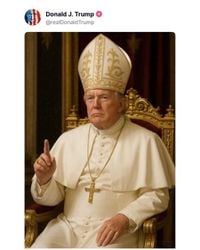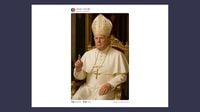Donald Trump, age 78, has ignited a firestorm of controversy with a KI-generated self-portrait depicting him as Pope, a move that has drawn sharp criticism from various quarters, especially within the Catholic community. The image, shared on Trump's Truth Social account and subsequently disseminated by the White House on Twitter, has not only raised eyebrows in the United States but has also caused a stir in the Vatican as the Catholic Church prepares for a crucial conclave.
The conclave, which begins on Wednesday, May 7, 2025, is set to select a successor to Pope Francis, who passed away on Easter Monday. As the 133 eligible cardinals gather to make this significant decision, Trump's antics have overshadowed the somber occasion, leading many to question the appropriateness of his actions.
Joseph Tobin, the Archbishop of Newark, New Jersey, was among the first to voice his discontent. Speaking to a reporter from RAI on Sunday, May 4, 2025, Tobin expressed his disappointment, stating, "Unfortunately, this is not a surprise." He lamented that Catholics in the U.S. would have to get used to such "humiliations" and remarked that there would be "many more opportunities" for such indignities in the future. This sentiment was echoed by Bishop Thomas Paprocki of Springfield, Illinois, who described the image as a "deep offense" to Catholics during this sacred time of mourning for Pope Francis.
On May 3, Paprocki took to X (formerly Twitter) to declare, "This is deeply offensive to Catholics especially during this sacred time that we are still mourning the death of Pope Francis and praying for the guidance of the Holy Spirit for the election of our new Pope. He owes an apology." His call for an apology reflects a broader sentiment among many who view Trump's actions as not just a joke but a mockery of the faith.
The New York State Catholic Conference also weighed in, stating unequivocally, "There is nothing clever or funny about this picture, Mr. President. We have just buried our beloved Pope Francis, and the cardinals are about to enter a solemn conclave to choose a new successor. Do not mock us." This statement underscores the gravity with which many in the Catholic community regard Trump's portrayal of himself in such a sacred role.
In Italy, the backlash has been equally severe. Former Prime Minister Matteo Renzi called the image shameful, arguing that it ridicules believers and mocks institutions. He lamented that it illustrates how the global right-wing leader enjoys playing the clown, further complicating Trump's already tenuous relationship with the Catholic Church, especially given his past conflicts with Pope Francis.
Trump's self-portrait shows him adorned in a white soutane, a golden cross around his neck, and a papal crown, all while sitting on a throne-like chair. Just days before posting the image, Trump had joked about wanting to be Pope himself, stating, "That would be my first choice." This light-hearted comment, juxtaposed with the gravity of the situation, has left many questioning Trump's sensibilities.
Despite the criticism, Trump has a base of supporters, including some sympathizers within the Vatican. His Vice President, JD Vance, age 40, has also been noted as having admirers among the cardinals. However, the prevailing sentiment among church leaders suggests that Trump's actions have severely damaged any goodwill he may have had.
As the conclave approaches, the implications of Trump's actions on the election process are significant. Cardinal Timothy Dolan, a prominent figure and abortion opponent, stated that Trump made a poor impression with his actions, which could further alienate him from the Catholic electorate. With approximately 20 percent of U.S. citizens identifying as Catholic and polls indicating that about 60 percent of Catholics voted for Trump in the last presidential election, his relationship with this demographic could be at risk.
Moreover, Trump's past comments about building walls rather than bridges have drawn criticism from Pope Francis, who famously remarked, "Anyone who only wants to build walls and not bridges is not a Christian." This historical tension between Trump and the late Pope adds another layer of complexity to the current situation.
The conclave, which will be conducted in secrecy, requires a two-thirds majority to elect a new Pope, a rule established by Pope Benedict XVI. Given the current climate, many commentators believe that the chances of a U.S. cardinal being elected are now virtually nonexistent. Cardinal Tobin himself expressed skepticism about the prospect, suggesting that an Italian cardinal is far more likely to be chosen.
As the world watches the events unfold, the question remains: what impact will Trump's controversial portrayal of himself as Pope have on the future of the Catholic Church and his own political aspirations? With the conclave set to begin soon, all eyes will be on the cardinals as they navigate this complex and fraught moment in history.
In the meantime, Trump's actions serve as a reminder of the delicate relationship between politics and faith, and how easily the two can become entangled in controversy. As reactions continue to pour in, it is clear that this incident has not only offended many but has also sparked a broader discussion about respect, faith, and the role of humor in serious matters.


